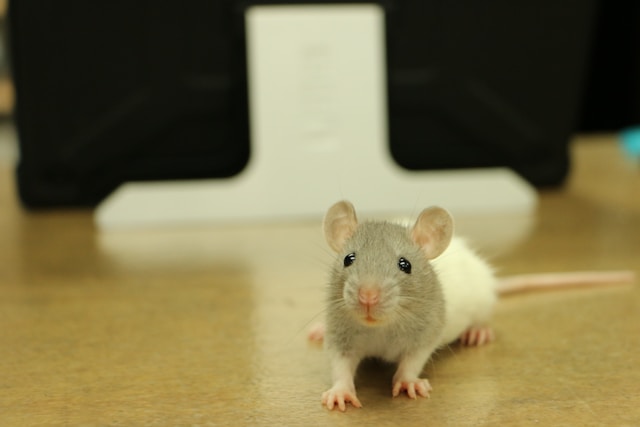
You’d be surprised how often mice sneak into homes, messing up the place and making it hard to keep things tidy and safe. Tackling this problem yourself can be super handy, saving you cash and time.
Smart tricks can help you handle these little pests without putting your family or pets at risk. Try out stuff like natural repellents, traps, or sealing up holes to keep them out.
Knowing what works and what doesn’t helps you make the best choices, making your home comfy and mouse-free.
Assessing the Infestation
Effectively managing a mouse problem starts with checking how bad it is. Spot signs early so you can handle them and stop things from getting worse.
Identifying Signs of Mice
Watch out for small droppings that look like black grains of rice and chew marks on stuff like furniture or food boxes. Spotting these early helps you see how serious it is and what to do next.
Checking Common Entry Points
Check out usual spots mice get in, like basements, attics, and near pipes and wires. Mice can squeeze through tiny gaps, so look closely. Catching these spots early can stop small problems from growing big.
Comprehensive Inspection and Documentation
Do a full check, including places like crawl spaces, laundry rooms, and under sinks. Use a flashlight for dark corners and jot down what you find in a notebook or on your phone.
This helps you make a good plan and saves time and money by focusing on the real problem. Jumping on it early not only fixes the current issue but also helps keep things under control later.
Effective Traps and Their Placement
Solving a mouse problem isn’t too tricky if you choose the right traps and know where to place them. Snap traps work by shutting quickly, while electric traps deliver a fast zap, making both options effective at catching mice.
For the best results, set traps along walls and near entry points like doors and windows, as these are common paths for mice. Baiting them with a little peanut butter or cheese can help draw them in.
Check traps regularly so you can remove any caught mice promptly, resetting them as needed, and always use sealed bags for disposal to keep things clean and safe.
Placing several traps at once will increase your chances of catching all the mice, making this a practical and humane DIY approach.
Natural Repellents That Work
If you’re trying to keep mice away without using chemicals, natural stuff can really help. Peppermint oil is a top pick because mice hate its strong smell. Just soak some cotton balls in it and put them around, like behind your fridge or in cupboards.
Vinegar’s another good one—mix it with water and spray it near windows and doors where mice might sneak in. Cayenne pepper’s also handy; sprinkle it in spots where mice might come through.
Remember, you’ll need to reapply these often since they lose their strength over time. Going this route is cheaper and safer, especially if you’ve got kids or pets. Try out different combos of these natural tricks to see what works best for keeping your home mouse-free.
Sealing Entry Points
Alright, here’s the scoop on keeping those pesky mice at bay: it’s all about sealing up any little nooks and crannies they might squeeze through. Mice are like tiny contortionists, able to slip through spaces as small as a coin!
So, closing up those sneaky entry points not only keeps them out but also saves you from constantly setting traps. Here’s a handy list of what you’ll need:
- Steel wool
- Caulk
- Foam insulation
First, have a good scout around your house, both inside and out. Pay special attention to spots around pipes, vents, and windows where gaps might let mice in. A torch is brilliant for spotting these in darker corners.
For those small gaps, stuff in some steel wool—it’s tough as nails, and mice can’t gnaw through it. For bigger holes, caulk or foam insulation should do the trick, sealing them up nice and tight.
This nifty trick is not just effective in keeping the little blighters out, but it’s also much cheaper than ringing up pest control every other month. Plus, it’s wise to give your home a regular once-over, especially as the seasons change, to spot any new gaps that might appear.
By sealing these openings, you’re not just reducing the need for traps; you’re also making your home a safer haven from future mouse invasions.
So, why not get cracking on sealing those gaps? You’ll not only save yourself some cash but also enjoy a mouse-free home.
Ineffective Methods to Avoid
Got a mouse problem? Be wary of DIY fixes that promise a lot but don’t deliver, wasting your time and cash.
Take those ultrasonic gadgets, for instance. Mice quickly adapt to the noise, making these devices mostly ineffective. Plus, the sound waves can’t penetrate walls or furniture, so they’re not a comprehensive solution.
Poison might seem like an easy answer, but it poses risks to kids and pets. And let’s not forget the unpleasant surprise of finding a dead mouse in an awkward spot, leaving your home with a lingering odour.
Then there are mothballs and dryer sheets—people think they’ll do the trick, but you’d need heaps for them to work, which isn’t practical or safe. As for home remedies like peppermint tea bags or onions, they generally fall short and just end up costing you more.
Why not try something more reliable, like traps and blocking entry points? This approach not only keeps mice out but also saves you money in the long run.
By sticking to methods that actually work, you can avoid the frustration of failed attempts. Simple and effective solutions mean less stress and a cosy, mouse-free home. So, next time you spot a mouse scurrying around, give these tips a go for some peace of mind.
When to Consider Professional Services
If your mouse problem isn’t going away despite your best DIY efforts, here are a few signs it might be time to bring in professional reinforcements:
- Severe or recurring problems: If traps and home remedies aren’t working, it’s time to bring in pest control experts who can deal with even the toughest infestations.
- Benefits of professional services: Professionals have access to stronger treatments and the skills to use them safely, which is especially important in homes with children or pets.
- Safety and efficiency: Experts can address the health risks mice pose without compromising safety, saving you both time and effort.
- Cost vs. damage: Compare the cost of hiring professionals with the potential damage and health hazards—expert help often proves the smarter investment.
Conclusion
Keeping mice away can be easier than you think with simple DIY tricks. Seal up holes and set traps where they work best. This cuts down on mice without costing much.
Natural repellents are also safe, especially with kids or pets around. If the problem’s too big or keeps returning, consider expert help. Mixing DIY methods with professional advice is a clever way to keep your home mouse-free. Try these tips and reclaim your space today!

Abdul Qadeer is highly experienced in creating engaging content that adds real value to a blog, website, or brand. He is creating content for multiple niches like technology, SEO, Marketing, Health, Education and Career Development, etc.